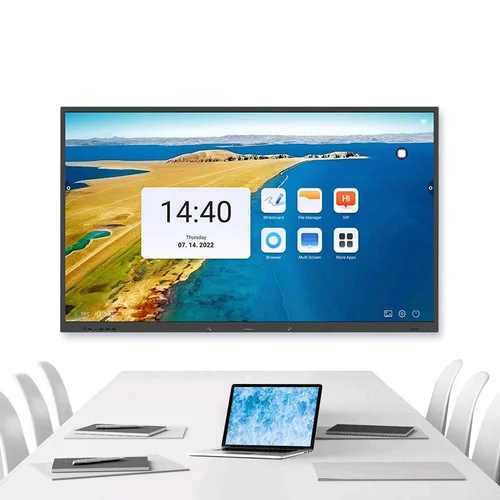Introduction
In an era where technology is continuously advancing, the 65-inch interactive flat panel represents a cutting-edge solution that integrates display technology with interactivity. This versatile tool has made significant strides in various fields, including education, business, healthcare, and public engagement. By blending the high-definition display of traditional monitors with interactive touch technology, the 65-inch interactive flat panel has become a transformative device in how we interact with digital content. This article delves into the features, advantages, applications, and emerging trends related to the 65-inch interactive flat panel, offering a comprehensive understanding of its impact and potential.
Defining the 65-Inch Interactive Flat Panel
A 65-inch interactive flat panel is a large-scale touchscreen display designed to offer a high-resolution visual experience combined with interactive capabilities. These panels are engineered to facilitate direct user interaction through touch, allowing for a more engaging and hands-on approach to digital content.
Key Characteristics:
Generous Screen Size: The 65-inch dimension provides a sizable viewing area, making it ideal for various environments where visibility from multiple angles is essential. This large screen ensures that content is visible to all participants, whether in a classroom, conference room, or public area.
Touchscreen Technology: Interactive flat panels feature advanced touchscreen technology, such as capacitive or infrared sensors. This technology supports multi-touch functionality, enabling multiple users to interact with the screen simultaneously, enhancing collaboration and engagement.
High-Definition Display: These panels typically offer high-definition resolutions, such as Full HD (1920×1080) or 4K Ultra HD (3840×2160). The high resolution ensures that text, images, and videos are displayed with exceptional clarity and detail.
Connectivity Options: A range of connectivity features, including HDMI, USB, and wireless capabilities, is integrated into the panel. This versatility allows seamless connection with other devices like computers, tablets, and mobile phones.
Software Integration: The interactive flat panel supports various software applications, from educational tools to collaborative platforms. This compatibility enhances its functionality and adaptability for different use cases.
Applications of the 65-Inch Interactive Flat Panel
The 65-inch interactive flat panel is used in various settings due to its versatility and advanced features. Here are some primary applications:
Education: In educational environments, the 65-inch interactive flat panel is revolutionizing teaching methods by offering interactive and engaging ways to present material. Teachers can utilize the panel to display lessons, incorporate multimedia content, and facilitate interactive activities.
Interactive Teaching: Educators can design lessons that involve student interaction, such as solving problems or participating in group activities directly on the screen. This hands-on approach helps maintain student engagement and fosters a more interactive learning environment.
Multimedia Integration: The ability to integrate videos, animations, and interactive simulations makes complex concepts more accessible and caters to diverse learning styles.
Business: In the corporate world, the 65-inch interactive flat panel enhances presentations, meetings, and collaborative projects. The large display ensures that all participants can view the content clearly, and the interactive features promote active engagement.
Dynamic Presentations: During meetings and presentations, the panel can display slides, charts, and other visual aids. Presenters can annotate and emphasize key points in real-time, making presentations more dynamic and interactive.
Collaborative Work: The interactive features support real-time collaboration, allowing team members to brainstorm, share documents, and provide feedback. This enhances productivity and fosters a collaborative work environment.
Healthcare: In healthcare settings, the interactive flat panel is used for patient education, medical training, and telemedicine.
Patient Education: Healthcare professionals can use the panel to explain medical conditions, treatment options, and procedures in an engaging and interactive manner, improving patient comprehension and involvement.
Medical Training: The panel can display detailed medical diagrams and conduct interactive simulations, aiding in the training of medical staff and enhancing their learning experience.
Retail and Public Spaces: The interactive flat panel is also effective in retail and public environments, where it can be utilized for digital signage, wayfinding, and customer engagement.
Digital Signage: Retailers can leverage the panel to showcase promotions, product information, and interactive advertisements, enhancing customer engagement and driving sales.
Wayfinding: In public spaces such as malls or airports, the panel can provide interactive maps and directions, helping visitors navigate more easily and improving their overall experience.
Benefits of the 65-Inch Interactive Flat Panel
The 65-inch interactive flat panel offers a range of benefits that enhance its effectiveness and utility across different applications:
Enhanced User Engagement: The interactive nature of the panel encourages active participation from users. By allowing users to interact directly with the content, the panel helps maintain interest and improves information retention.
Versatile Functionality: The panel’s support for various applications and software makes it a highly adaptable tool. Whether used for teaching, business meetings, or public displays, it caters to a wide range of needs.
Improved Collaboration: The large display and interactive features facilitate real-time collaboration among multiple users. This promotes effective teamwork, brainstorming, and decision-making.
Superior Visual Quality: The high-definition display ensures that all content is presented with clarity and detail. This is particularly important for presentations, educational content, and multimedia applications.
User-Friendly Interface: The touch-sensitive interface is intuitive and easy to navigate. Users can quickly learn how to operate the panel, reducing the learning curve and increasing efficiency.
Challenges and Considerations
Despite its many advantages, the 65-inch interactive flat panel also presents some challenges and considerations:
Cost: The initial investment in a 65-inch interactive flat panel can be significant. Organizations must evaluate the cost against the benefits to determine if the investment aligns with their needs and budget.
Space Requirements: The large size of the panel requires sufficient space for installation and use. Organizations must ensure that they have adequate room to accommodate the panel and provide a comfortable viewing distance for users.
Maintenance and Support: Regular maintenance and technical support are essential for keeping the panel in optimal condition. Organizations should have a plan in place for addressing technical issues and performing routine maintenance.
Integration: Integrating the panel with existing systems and workflows may require adjustments and additional training. Ensuring compatibility with other devices and software is crucial for effective use.
Content Management: Managing and updating content on the panel can be time-consuming. Organizations should develop a strategy for organizing and maintaining digital content to ensure it remains relevant and up-to-date.
Future Trends and Innovations
The field of interactive technology is continually evolving, and the 65-inch interactive flat panel is likely to see several advancements in the coming years. Some potential future trends include:
Advanced Touch Technology: Future panels may incorporate more sophisticated touch technologies, such as haptic feedback and gesture recognition. These innovations could enhance interactivity and user experience.
Integration with Artificial Intelligence (AI): AI could provide personalized interactions and analytics, allowing for more tailored content and improved user engagement.
Augmented Reality (AR) and Virtual Reality (VR): The integration of AR and VR with interactive flat panels could create immersive experiences, transforming how we interact with digital content and offering new possibilities for education and training.
Enhanced Connectivity: Future panels may offer improved connectivity options, including better integration with other digital devices and platforms, facilitating more seamless interactions.
Sustainability: As environmental concerns become increasingly important, future interactive panels may focus on sustainability and energy efficiency. This could include features such as low-power modes and the use of eco-friendly materials.
Conclusion
The 65-inch interactive flat panel represents a significant advancement in digital technology, offering a versatile and engaging platform for a wide range of applications. Its large display, interactive capabilities, and high-definition visuals make it an invaluable tool for enhancing presentations, facilitating collaboration, and enriching educational experiences.
As technology continues to evolve, the potential for the 65-inch interactive flat panel to further transform how we interact with digital content is substantial. By addressing current challenges and embracing future trends, the interactive flat panel will continue to play a crucial role in shaping the future of communication and collaboration.
Keep an eye for more news & updates on Tech Sky!

